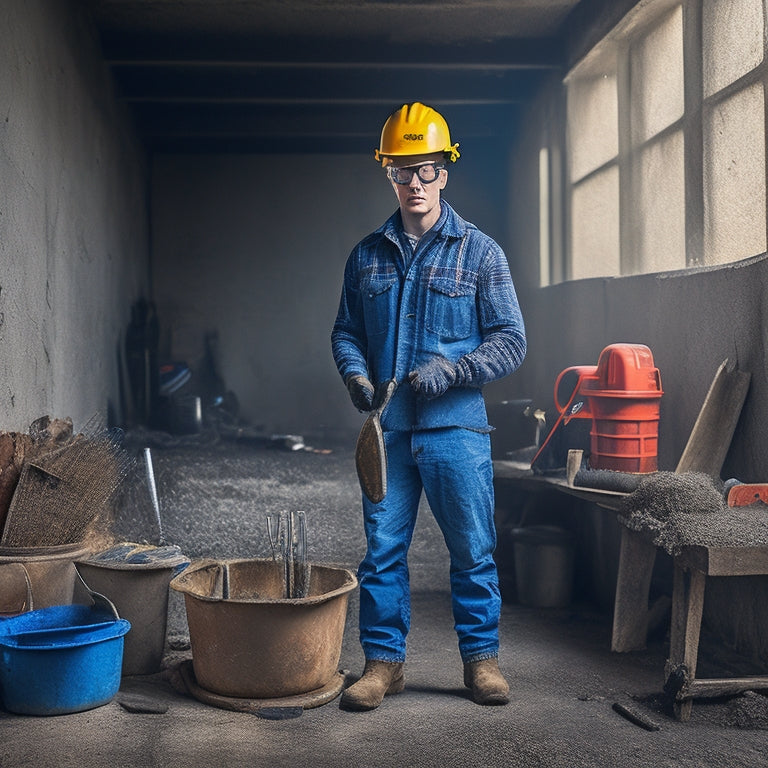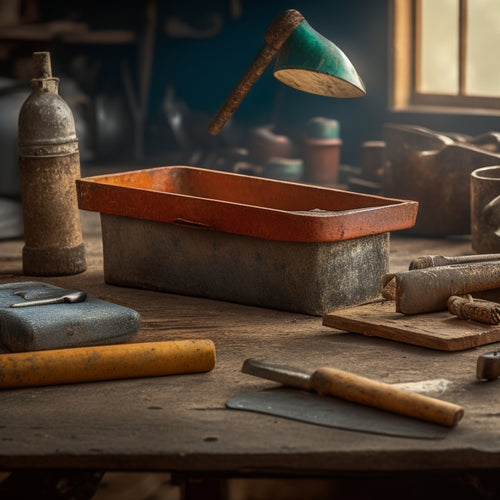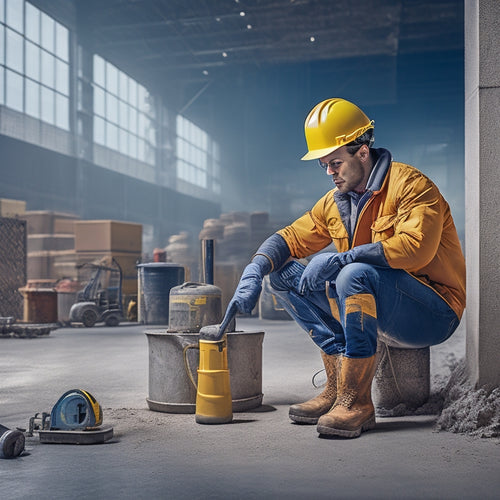
What Tools Do I Need for Concrete Wall Repair
Share
As you prepare for a concrete wall repair job, you'll need a variety of tools to guarantee a successful outcome. Start with essential hand tools like hammers, chisels, wire brushes, trowels, and levels. For heavy-duty repairs, power tools like high-torque drills, demolition hammers, and concrete grinding machines are necessary. Specialized tools like crack injection guns, epoxy repair kits, and precision tools will help you tackle cracks and defects. Don't forget safety equipment, measuring tools, and cleaning gear. With the right tools, you'll be well-equipped to tackle your concrete wall repair project - and by exploring further, you'll uncover the specific techniques and best practices to guarantee a flawless finish.
Key Takeaways
- Essential hand tools like hammers, chisels, and wire brushes are necessary for breaking up damaged concrete and preparing the repair area.
- Power tools like drills, demolition hammers, and concrete grinding machines are required for heavy-duty repair tasks and smoothing rough surfaces.
- Specialized tools like crack injection guns, epoxy repair kits, and crack chaser blades are needed for effectively repairing cracks and defects.
- Safety equipment and gear, including hard hats, safety glasses, and protective gloves, are crucial for protecting yourself from hazards during the repair process.
- Measuring and testing tools, such as tape measures, crack width gauges, and compression strength testing equipment, are necessary for evaluating the extent of damage and ensuring a successful repair.
Essential Hand Tools Needed
Equipped with the right tools, you'll be well-prepared to tackle concrete wall repair projects efficiently and effectively. When it comes to concrete wall repair, having the essential hand tools is vital for tackling various repair techniques and wall types.
You'll need a hammer for breaking up damaged concrete, a chisel for removing old mortar, and a wire brush for cleaning the area. A trowel is necessary for applying new concrete, while a level guarantees the surface is even. Don't forget a putty knife for scraping away excess material and a mixing bucket for preparing the repair mixture.
For more precise work, add a utility knife, pliers, and a screwdriver to your arsenal. These tools will help you navigate tight spaces and make necessary adjustments.
With these hand tools, you'll be able to tackle common concrete wall repair projects, such as fixing cracks, patching holes, and replacing damaged sections. By having the right tools, you'll be able to focus on mastering the repair techniques and getting the job done efficiently, rather than wasting time searching for the right equipment.
Power Tools for Heavy-Duty Repair
You'll need to bring out the big guns for heavy-duty concrete wall repair, and that means power tools.
For drilling and demolition, you'll require high-torque drills and breakers that can handle the toughest concrete.
Concrete grinding machines will also be essential for smoothing out rough surfaces and preparing them for repair.
Drilling and Demolition
When tackling heavy-duty concrete wall repair, drilling and demolition are often unavoidable steps in the process. You'll need the right tools to get the job done efficiently and effectively.
For drilling, you'll require a rotary hammer drill or a demolition hammer, depending on the task at hand. These power tools will help you execute various drilling techniques, such as core drilling, anchor drilling, or simply making holes for anchors or rebar.
For demolition, you'll need to choose the right demolition method for the job. This might involve using a jackhammer, a demo saw, or even a pry bar. The key is to select the tool that will allow you to safely and efficiently remove the damaged concrete without causing further damage to the surrounding area.
Remember to always follow safety protocols when working with power tools, and take necessary precautions to contain dust and debris. By having the right drilling and demolition tools, you'll be well-equipped to tackle even the most challenging concrete wall repair projects.
Concrete Grinding Machines
After removing damaged concrete, you're left with a rough, uneven surface that requires smoothing out. That's where concrete grinding machines come in - the power tools for heavy-duty repair. These machines are designed to level, smooth, and polish concrete surfaces, making them a crucial tool for any concrete wall repair project.
-
Imagine a machine that can grind down rough concrete to a smooth finish, perfect for applying a new coat of paint or epoxy.
-
Picture a device that can effortlessly remove old adhesive, dirt, and grime, leaving your surface clean and ready for repair.
-
Envision a tool that can tackle even the toughest concrete surfaces, from rough to refined in no time.
- Visualize a machine that makes quick work of uneven surfaces, leaving you with a perfectly level finish.
When it comes to grinding techniques, it's vital to use the right machine for the job. Choose a grinder that suits your project's specific needs, and don't forget to perform regular machine maintenance to guarantee peak performance.
With the right concrete grinding machine and proper techniques, you'll be well on your way to a smooth, even surface that's ready for repair.
Specialized Tools for Cracks
Cracks in concrete walls require precision repair to prevent further damage and guarantee structural integrity. You'll need specialized tools to get the job done right. For crack injection, you'll need a crack injection gun, which applies epoxy or polyurethane resin into the crack. This is a vital step, as it helps to bond the concrete and prevent further damage.
| Tool | Function | Importance |
|---|---|---|
| Crack Injection Gun | Applies epoxy or polyurethane resin into the crack | High |
| Epoxy Repair Kit | Provides the necessary materials for epoxy repair | High |
| Crack Chaser Blade | Cuts a V-shaped groove in the crack to prepare it for repair | Medium |
When it comes to epoxy repair, you'll need an epoxy repair kit that includes the necessary materials, such as resin and hardener. A crack chaser blade is also essential, as it cuts a V-shaped groove in the crack to prepare it for repair. Remember, precision is key when it comes to crack repair. With the right tools, you'll be able to restore your concrete wall to its former glory.
Safety Equipment and Gear
You've assembled the necessary tools for crack repair, now it's time to guarantee you're properly equipped to handle the job safely.
Safety protocols are vital when working with concrete, and personal protective gear is essential to prevent injuries.
-
Hard hat or safety helmet to protect your head from falling debris or tools
-
Safety glasses or goggles to shield your eyes from dust and flying particles
-
Dust mask or respirator to prevent inhaling concrete dust and other hazardous materials
- Steel-toed boots or shoes with good traction to prevent slips and falls
Measuring and Testing Tools
When you're evaluating a concrete wall for repair, you'll need to accurately measure defects and damage to determine the right course of action.
To do this, you'll use tools that profile the concrete surface, providing detailed information about its topography.
You'll also use compression strength testing equipment to determine the wall's structural integrity and identify areas that require repair or replacement.
Measuring Defects and Damage
Identifying the extent of damage is essential in concrete wall repair, and that's where measuring defects and damage comes in.
You need to determine the severity and scope of the problem to develop an effective repair strategy. Measuring defects and damage involves evaluating the cracks, spalls, and other issues that plague your concrete wall.
To do this, you'll need some essential tools, including:
- A tape measure or ruler to measure the length and width of cracks and spalls
- A crack width gauge to measure the width of hairline cracks
- A depth gauge to measure the depth of spalls and other damage
- A laser level or straightedge to identify unevenness and misalignment
Concrete Surface Profiling
Concrete surface profiling is a critical step in measuring and testing tools for concrete wall repair, as it provides a detailed assessment of the surface's topography. You'll want to examine the surface texture, which can reveal hidden defects, unevenness, or irregularities. Profiling techniques help you identify these issues, allowing you to plan the repair accordingly.
| Profiling Technique | Description | Surface Texture Revealed |
|---|---|---|
| Visual Inspection | Visual examination of the surface | Cracks, spalling, unevenness |
| Laser Profiling | Uses laser technology to create a 3D model | Micro-irregularities, surface roughness |
| Sand Patch Method | Applies a sand patch to the surface | Surface roughness, texture |
Compression Strength Testing
With a thorough understanding of the surface texture and topography from profiling, you're now ready to assess the concrete wall's internal properties.
Compression strength testing is a critical step in evaluating the concrete durability. This involves measuring the compressive strength of the concrete, which is the ability of the material to withstand crushing forces.
- A hydraulic compression testing machine with a digital display, capable of exerting massive force (think: squishing a car)
- A set of cylindrical concrete test specimens, carefully extracted from the wall using a coring drill
- A calibration device, ensuring the testing machine is accurate and reliable
- A pair of safety glasses, because, well, you never know when a concrete specimen might decide to explode under pressure
Cleaning and Preparation Tools
Behind the success of a concrete wall repair project lies thorough surface preparation, which begins with the right cleaning and preparation tools.
You'll need a wire brush or a scrub brush to remove dirt, grime, and old adhesive residue from the surface. A pressure washer can also come in handy for more stubborn stains or heavy buildup.
When it comes to surface cleaning, you'll want to use a degreaser or a concrete cleaner to break down oils and dirt. Make sure to follow the manufacturer's instructions and take necessary safety precautions.
For more thorough preparation techniques, consider using a floor scraper or a concrete scraper to remove old coatings or loose concrete. A putty knife or a trowel can also be used to fill in gaps and cracks.
Frequently Asked Questions
Can I Use Regular Cement for Concrete Wall Repair?
When tackling concrete wall repair, you shouldn't settle for regular cement, as it lacks the specialized properties needed for durable bonding and structural integrity; instead, choose a repair-specific material, and master those advanced repair techniques for a job that'll last.
Do I Need a Professional for Minor Wall Cracks?
You're wondering if you can tackle that minor crack solo, but don't be too quick to grab your DIY cape; a thorough minor crack assessment is essential, and we've got the DIY repair tips to help you decide if you really need a pro.
Can I Repair a Concrete Wall in Cold Weather?
You can repair a concrete wall in cold weather, but be aware of cold weather considerations; winter concrete techniques require specialized mixes, slower curing, and protection from frost to guarantee a strong, long-lasting fix.
How Long Does Concrete Wall Repair Usually Take?
Hey, don't worry if you're not a concrete wizard - you can still tackle that wall repair! Typically, repair timeframes vary depending on the extent of wall damage, but expect anywhere from a few hours to several days, depending on the complexity of the fix.
Can I Paint Over Repaired Concrete Walls Immediately?
You shouldn't paint over repaired concrete walls immediately; instead, you'll need to master some painting techniques, ensuring proper surface preparation, or you'll end up with a peeling, flaking mess that'll make you cry (and not from laughter, unfortunately)!
Conclusion
When you've gathered all the necessary tools for concrete wall repair, you'll be ready to tackle that challenging task head-on. Remember, having the right tools is half the battle - now it's time to roll up your sleeves and get to work. With these tools in your arsenal, you'll be able to crack open the repair process and hammer out a solution that will stand the test of time.
Related Posts
-

Smart Guide to Buying Used Concrete Hand Tools
You're about to buy used concrete hand tools, and you need to get it right. Dedicate time to identify the tools you n...
-

10 Best Tools for Sealed Concrete Flooring on Budget
When starting on a sealed concrete flooring project on a budget, you'll need to prioritize essential tools without sa...
-

Best Tools for Concrete Restoration and Repair
When tackling concrete restoration and repair projects, you need a range of reliable tools to achieve professional-gr...


